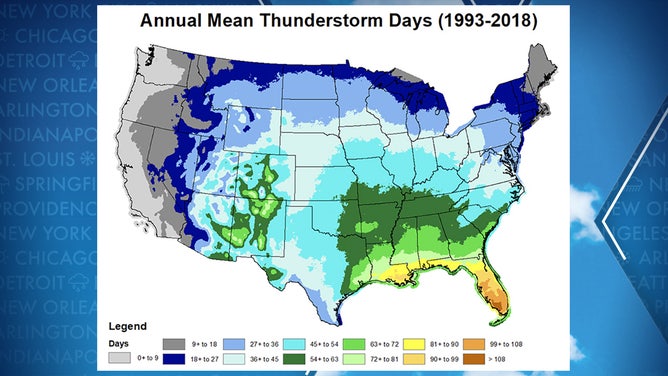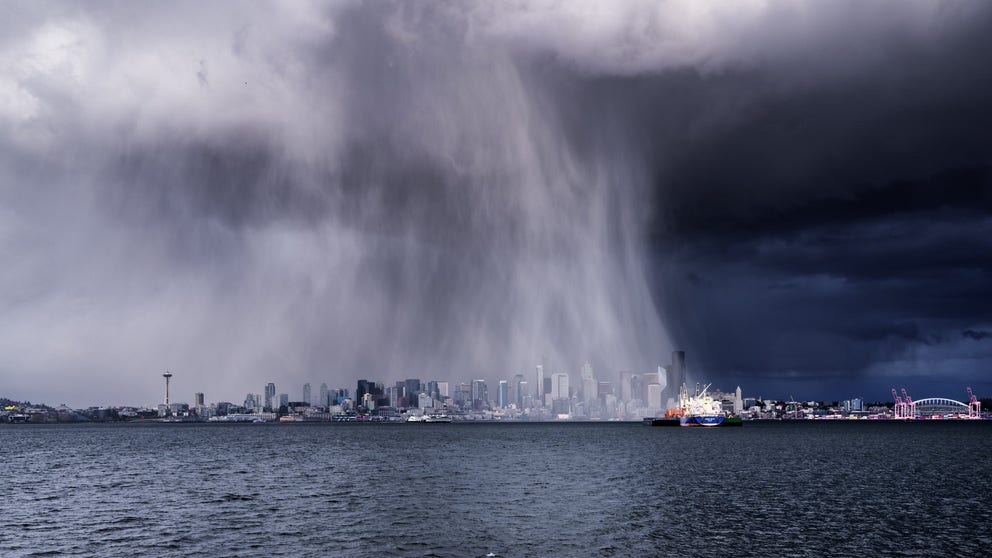Why are thunderstorms so rare along the Pacific coast?
Along the Pacific Ocean, the cool waters keep temperature changes minimal, making an unfavorable environment for thunderstorm development. Much of the region west of the Cascades and Sierra Nevada mountain range averages nine days or less per year of reported lightning.
Watch: Dramatic curtain of hail drapes over the Seattle skyline
Ribbons of hail fell across Downtown Seattle in April 2022 putting on a show of nature across the Emerald City's skyline.
In the Midwest and along the Eastern Seaboard, thunderstorms can sometimes be a nightly occurrence, if not at least a few times a week. Those storms will occasionally be severe, with strong wind gusts, large hail, heavy precipitation and perhaps a rare tornado.
But residents along the Pacific coast can go months without hearing so much as a rumble of thunder. And even when those rare thunderstorms pop up, they're usually relatively puny compared to the rest of the nation's standards, with supercell thunderstorms nearly unheard of.
Weak tornadoes have been observed over the years, but luckily no one has been killed by a tornado in the Pacific Northwest since a tornado killed six and injured 300 in Vancouver, Washington, in April 1972.
Why is the weather out West so relatively tame?
A majority of the weather for the West Coast comes off the Pacific Ocean. Unlike the waters along the Gulf Coast or the Atlantic Ocean beaches, which feel like stepping in a warm bath, stepping in the Pacific Ocean is usually followed by a shriek from frigid toes. Water temperatures remain in the 50s throughout the year, providing a vast moderating effect on the incoming weather.

This file photo shows water temperatures in the Pacific Ocean in October 2021.
(FOX Weather)
Thunderstorms thrive in environments where there are significant temperature changes with height. Suppose much cooler air is moving in or sitting aloft. In that case, warmer air parcels rising from the ground can climb higher into the atmosphere, making for taller, stronger storms that graduate into thunderstorms.
In the Midwest and East Coast, you have battles from cooler continental Canadian air mixing with the warm waters of the Gulf, making for strong cold fronts. Or the afternoons are hot enough, and the atmosphere is moist enough to trigger spontaneous thunderstorm development.
In Florida, the lightning capital of the U.S., daily battles between the relatively cooler sea breezes and warm land masses mixed with an ample supply of tropical moisture and heat make thunderstorms a regular occurrence. Parts of South Florida average well over 100 days a year, with a thunderstorm reported.

Average thunderstorm days.
(NOAA)
But along the Pacific Ocean, the cool waters keep temperature changes minimal, making an unfavorable environment for thunderstorm development. Much of the region west of the Cascades and Sierra Nevada mountain range averages nine days or less per year of reported lightning.
And even when thunderstorms do form, it's usually due to borderline atmospheric conditions leaving them relatively weak with small hail, occasional lightning and a passing drenching rain shower.
HOW TO STAY SAFE DURING A THUNDERSTORM
However, even weak thunderstorms can be dangerous. Lightning, whether it's one strike or 100 strikes in a storm, can still be deadly and/or damaging.
Lightning strikes tree, sending sparks flying along nearby fence
A vivid lightning strike not only struck a tree in a North Carolina backyard but sent a jolt through the ground to a nearby fence, creating a cascade of sparks. (Video courtesy: Sharon Mitchell)
This chart, courtesy of Iowa State University, illustrates the absence of major lightning along the Pacific coast by showing the number of Severe Thunderstorm Warnings issued by each National Weather Service office since 2015.

Number of Severe Thunderstorm Warnings issued by National Weather Service Office from Jan. 1, 2015 to March 25, 2025.
(IEM / Iowa State University / FOX Weather)
So don't blame a Pacific coast resident for getting excited on social media over what might seem like a run-of-the-mill thunderstorm. It's a rare show out there.

